TMGT603 Leadership and Ethical Behavior: Firestone Case Study
VerifiedAdded on 2023/04/21
|10
|2630
|262
Case Study
AI Summary
This case study examines the Firestone tire recall, a significant event highlighting ethical dilemmas in business leadership. The assignment analyzes the conflict between commercial interests and public safety concerns, focusing on the leadership's role in navigating this complex situation. The study explores ethical leadership theories, such as utilitarianism and transformational leadership, and their application in the Firestone case. It evaluates the company's actions, the impact of defective tires, and the subsequent crisis management. The case study proposes a framework for resolving ethical dilemmas, including problem identification, course of action, and monitoring progress. It emphasizes the importance of ethical decision-making, internal codes of conduct, and the need for leaders to balance multiple perspectives for better outcomes. The analysis covers Firestone's shortcomings, the importance of customer safety, and the need for proactive measures to ensure corporate social responsibility. The conclusion underscores the significance of ethical leadership in fostering a culture of accountability and promoting the well-being of stakeholders, as well as the consequences of prioritizing profits over public safety.
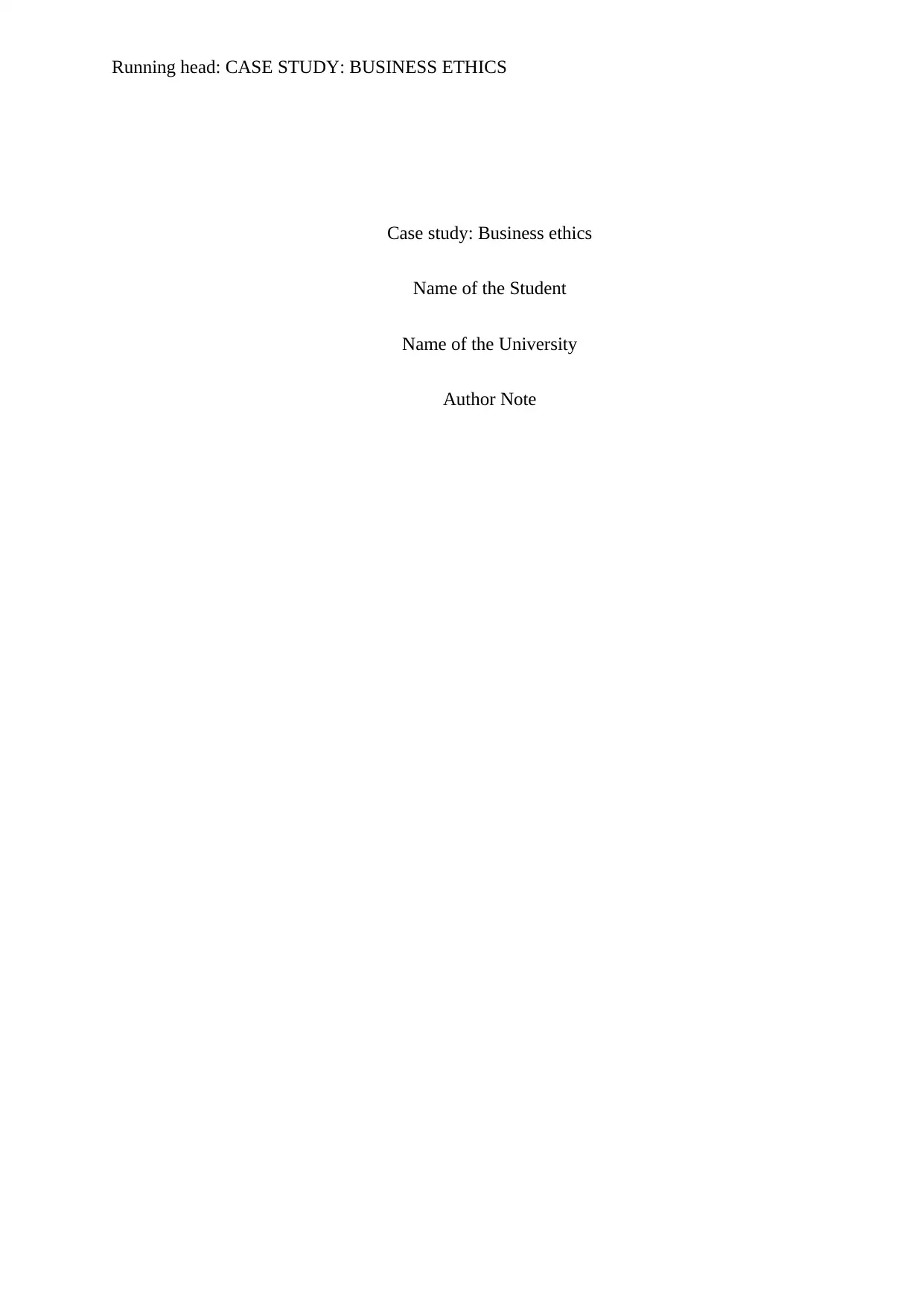
Running head: CASE STUDY: BUSINESS ETHICS
Case study: Business ethics
Name of the Student
Name of the University
Author Note
Case study: Business ethics
Name of the Student
Name of the University
Author Note
Paraphrase This Document
Need a fresh take? Get an instant paraphrase of this document with our AI Paraphraser
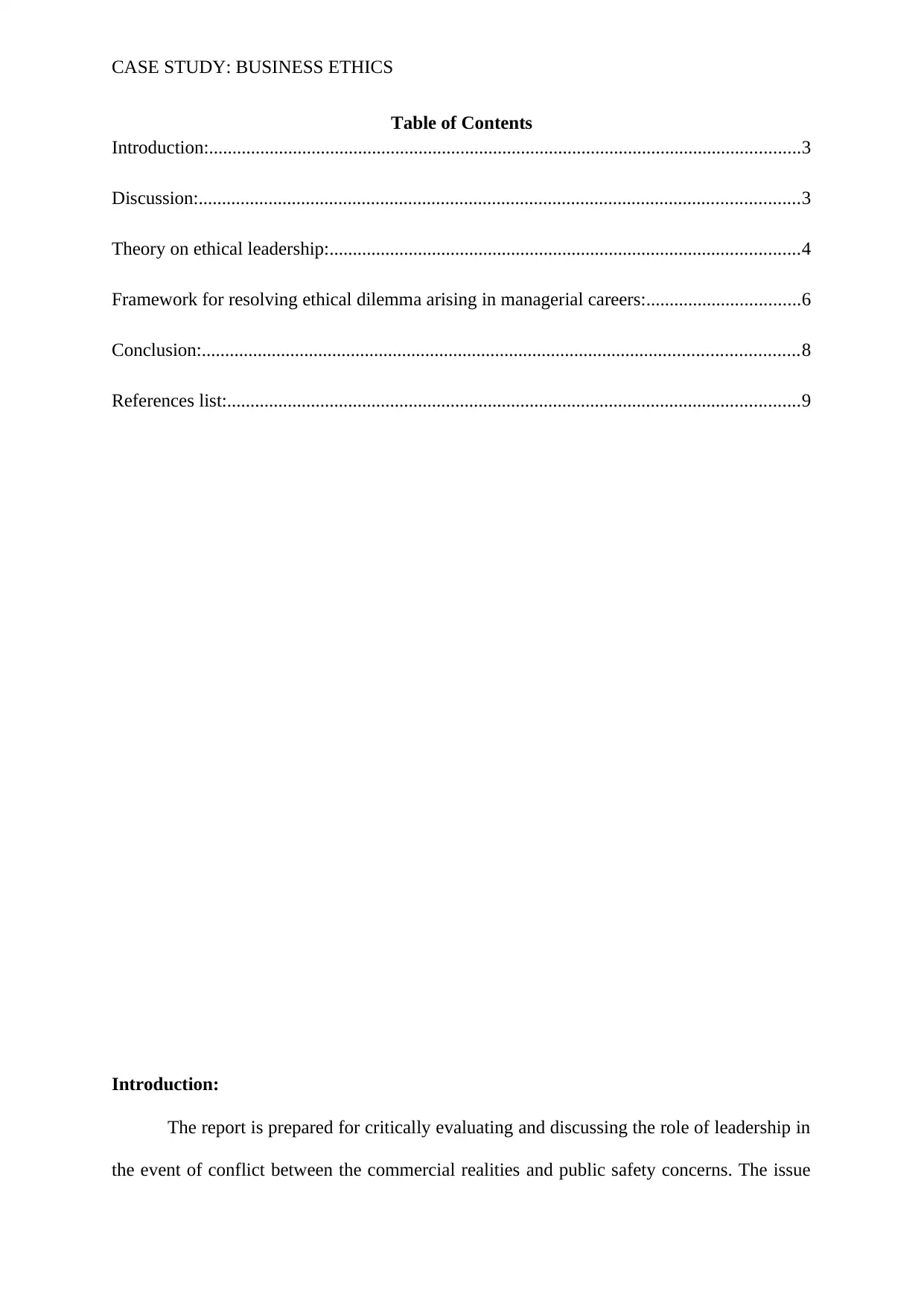
CASE STUDY: BUSINESS ETHICS
Table of Contents
Introduction:...............................................................................................................................3
Discussion:.................................................................................................................................3
Theory on ethical leadership:.....................................................................................................4
Framework for resolving ethical dilemma arising in managerial careers:.................................6
Conclusion:................................................................................................................................8
References list:...........................................................................................................................9
Introduction:
The report is prepared for critically evaluating and discussing the role of leadership in
the event of conflict between the commercial realities and public safety concerns. The issue
Table of Contents
Introduction:...............................................................................................................................3
Discussion:.................................................................................................................................3
Theory on ethical leadership:.....................................................................................................4
Framework for resolving ethical dilemma arising in managerial careers:.................................6
Conclusion:................................................................................................................................8
References list:...........................................................................................................................9
Introduction:
The report is prepared for critically evaluating and discussing the role of leadership in
the event of conflict between the commercial realities and public safety concerns. The issue

CASE STUDY: BUSINESS ETHICS
of the ethical dilemma is explained in reference to the case of Firestone Tyre Company which
was perhaps the biggest auto safety crisis in the history of United States. Such dilemma
ensuing for leaders in the given circumstances is addressed in the report. This particular case
has been accounted for as it focuses on the ethical decision making during the event of
corporate crisis. It was found that in a gesture of concern for safety of public, Firestone
recalled several million of tires. Potential disaster was faced by Firestone with threat from its
largest customer and with public replacing millions of tires each year (Chen et al. 2016).
Therefore, the emphasis of the case is decision making with a particular focus on ethical
considerations against the financial objectives. The role of leadership in the situation of
ethical dilemma would be addressed by giving an explanation on the role and characteristics
of ethical leadership.
Discussion:
The guidelines seeking the good of others and honesty has the same application in
commerce just as they have in other aspects of life. It would be embarrassing and costly for
Firestone conceding that it has produced and sold tires to public that are unsafe. From the
case study, it is ascertained that Firestone was ignorant about the health and safety of public
as they were negligent about the quality of their product. The defective tires manufactured by
Firestone possibly would have caused a number of deaths across the country. Such disastrous
auto wrecks and failure of tires causing injury of thousands of people has led to ending of the
relationship of Ford with the Firestone. The company instead of accepting their mistakes
blamed its long standing customer for producing faulty and dangerous products (Murphy and
Laczniak 2016).
of the ethical dilemma is explained in reference to the case of Firestone Tyre Company which
was perhaps the biggest auto safety crisis in the history of United States. Such dilemma
ensuing for leaders in the given circumstances is addressed in the report. This particular case
has been accounted for as it focuses on the ethical decision making during the event of
corporate crisis. It was found that in a gesture of concern for safety of public, Firestone
recalled several million of tires. Potential disaster was faced by Firestone with threat from its
largest customer and with public replacing millions of tires each year (Chen et al. 2016).
Therefore, the emphasis of the case is decision making with a particular focus on ethical
considerations against the financial objectives. The role of leadership in the situation of
ethical dilemma would be addressed by giving an explanation on the role and characteristics
of ethical leadership.
Discussion:
The guidelines seeking the good of others and honesty has the same application in
commerce just as they have in other aspects of life. It would be embarrassing and costly for
Firestone conceding that it has produced and sold tires to public that are unsafe. From the
case study, it is ascertained that Firestone was ignorant about the health and safety of public
as they were negligent about the quality of their product. The defective tires manufactured by
Firestone possibly would have caused a number of deaths across the country. Such disastrous
auto wrecks and failure of tires causing injury of thousands of people has led to ending of the
relationship of Ford with the Firestone. The company instead of accepting their mistakes
blamed its long standing customer for producing faulty and dangerous products (Murphy and
Laczniak 2016).
⊘ This is a preview!⊘
Do you want full access?
Subscribe today to unlock all pages.

Trusted by 1+ million students worldwide
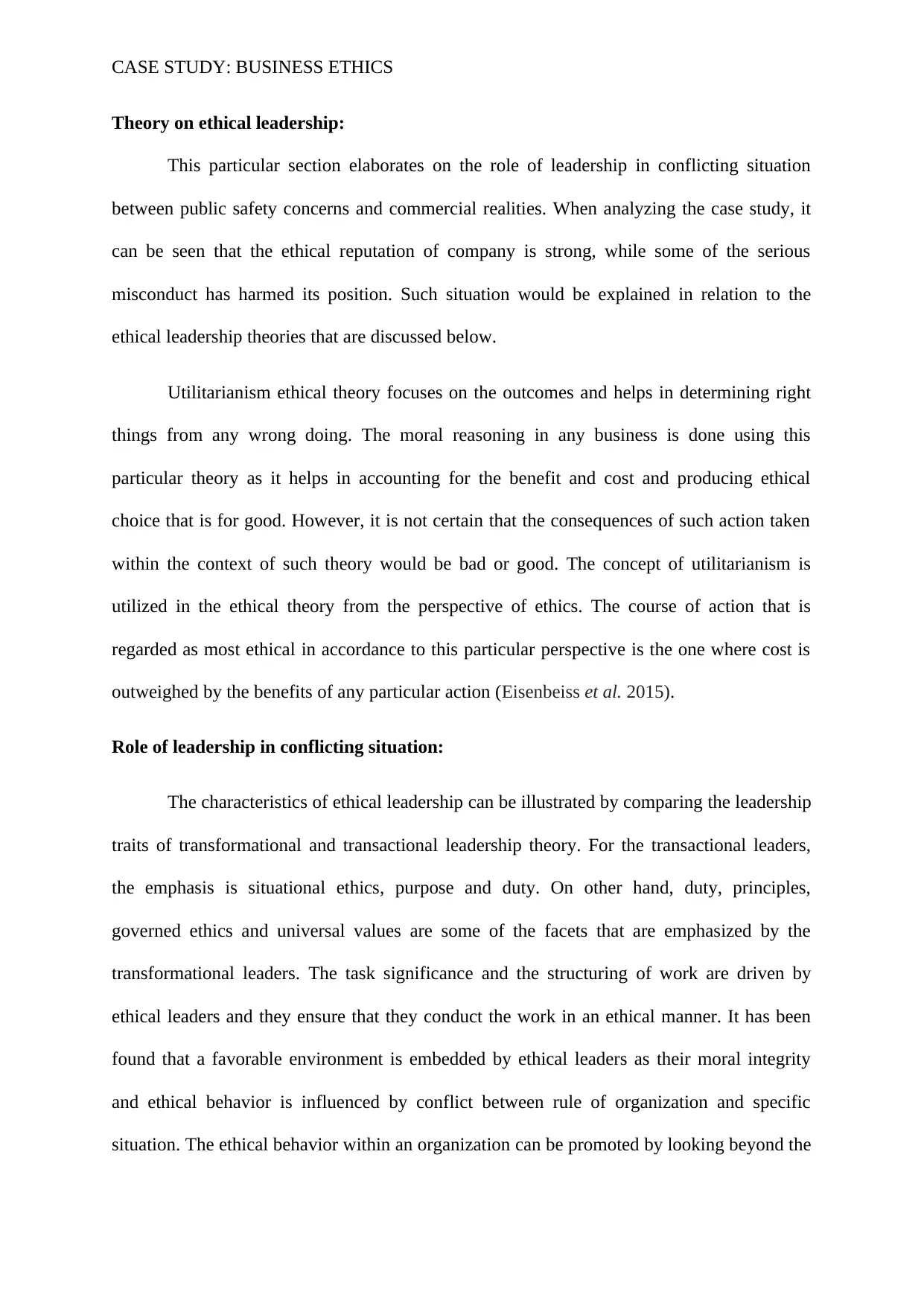
CASE STUDY: BUSINESS ETHICS
Theory on ethical leadership:
This particular section elaborates on the role of leadership in conflicting situation
between public safety concerns and commercial realities. When analyzing the case study, it
can be seen that the ethical reputation of company is strong, while some of the serious
misconduct has harmed its position. Such situation would be explained in relation to the
ethical leadership theories that are discussed below.
Utilitarianism ethical theory focuses on the outcomes and helps in determining right
things from any wrong doing. The moral reasoning in any business is done using this
particular theory as it helps in accounting for the benefit and cost and producing ethical
choice that is for good. However, it is not certain that the consequences of such action taken
within the context of such theory would be bad or good. The concept of utilitarianism is
utilized in the ethical theory from the perspective of ethics. The course of action that is
regarded as most ethical in accordance to this particular perspective is the one where cost is
outweighed by the benefits of any particular action (Eisenbeiss et al. 2015).
Role of leadership in conflicting situation:
The characteristics of ethical leadership can be illustrated by comparing the leadership
traits of transformational and transactional leadership theory. For the transactional leaders,
the emphasis is situational ethics, purpose and duty. On other hand, duty, principles,
governed ethics and universal values are some of the facets that are emphasized by the
transformational leaders. The task significance and the structuring of work are driven by
ethical leaders and they ensure that they conduct the work in an ethical manner. It has been
found that a favorable environment is embedded by ethical leaders as their moral integrity
and ethical behavior is influenced by conflict between rule of organization and specific
situation. The ethical behavior within an organization can be promoted by looking beyond the
Theory on ethical leadership:
This particular section elaborates on the role of leadership in conflicting situation
between public safety concerns and commercial realities. When analyzing the case study, it
can be seen that the ethical reputation of company is strong, while some of the serious
misconduct has harmed its position. Such situation would be explained in relation to the
ethical leadership theories that are discussed below.
Utilitarianism ethical theory focuses on the outcomes and helps in determining right
things from any wrong doing. The moral reasoning in any business is done using this
particular theory as it helps in accounting for the benefit and cost and producing ethical
choice that is for good. However, it is not certain that the consequences of such action taken
within the context of such theory would be bad or good. The concept of utilitarianism is
utilized in the ethical theory from the perspective of ethics. The course of action that is
regarded as most ethical in accordance to this particular perspective is the one where cost is
outweighed by the benefits of any particular action (Eisenbeiss et al. 2015).
Role of leadership in conflicting situation:
The characteristics of ethical leadership can be illustrated by comparing the leadership
traits of transformational and transactional leadership theory. For the transactional leaders,
the emphasis is situational ethics, purpose and duty. On other hand, duty, principles,
governed ethics and universal values are some of the facets that are emphasized by the
transformational leaders. The task significance and the structuring of work are driven by
ethical leaders and they ensure that they conduct the work in an ethical manner. It has been
found that a favorable environment is embedded by ethical leaders as their moral integrity
and ethical behavior is influenced by conflict between rule of organization and specific
situation. The ethical behavior within an organization can be promoted by looking beyond the
Paraphrase This Document
Need a fresh take? Get an instant paraphrase of this document with our AI Paraphraser

CASE STUDY: BUSINESS ETHICS
ethics of decision making by reshaping the firms incentive and culture (Kaul and Desai
2017). It is culminated by overreaching trend that the performance of company is
increasingly measured on the basis of long term performance quality and sustainable profits.
The performance of company is also judged by turning to sustainability and environmental
issues, governance and social responsibility. Now a day, the clear outcome of better
governance and leadership is reflected in the stability and sustainable profit margins. In such
scenario, it is believed that ethical leaders not only contribute to the organization by making it
efficient, but making it a more ethical organization (Murphy and Laczniak 2016). There is a
growing strong demand for control of market and companies and governmental regulations.
Moral agency is believed to foster by ethical leadership by acting autonomously with no fear
of the repercussion on career ad employability and exercising moral judgment. There does
not seem to have transformational effect by embedding process like publishing ethical
policies and codes. Ethical leadership forms the basis of successful implementation of
principles of corporate social responsibility (Valentine et al. 2016).
Ethical leadership is defined as demonstrating the appropriate conduct by way of
promotion of conduct through interpersonal relations and personal actions. Employees
received moral guidance from the ethical leaders through their personal and professional
lifestyle so that they refrain from getting involved in harmful behavior. They are also guided
to advocate their best interest by making use of social power. Managers in both large and
small scale organization faces difficult situation concerning ethics and the ethical elements
embedded in the day to day functions are recognized by the managers (Davidson et al. 2015).
In many situations, there arise such ethical laden situations when judged by the code of
conduct or value of organization that are clearly right or wrong. However, such situations are
not considered to be ethically problematic as most of the actions and decisions of managers
are considered to be legal.
ethics of decision making by reshaping the firms incentive and culture (Kaul and Desai
2017). It is culminated by overreaching trend that the performance of company is
increasingly measured on the basis of long term performance quality and sustainable profits.
The performance of company is also judged by turning to sustainability and environmental
issues, governance and social responsibility. Now a day, the clear outcome of better
governance and leadership is reflected in the stability and sustainable profit margins. In such
scenario, it is believed that ethical leaders not only contribute to the organization by making it
efficient, but making it a more ethical organization (Murphy and Laczniak 2016). There is a
growing strong demand for control of market and companies and governmental regulations.
Moral agency is believed to foster by ethical leadership by acting autonomously with no fear
of the repercussion on career ad employability and exercising moral judgment. There does
not seem to have transformational effect by embedding process like publishing ethical
policies and codes. Ethical leadership forms the basis of successful implementation of
principles of corporate social responsibility (Valentine et al. 2016).
Ethical leadership is defined as demonstrating the appropriate conduct by way of
promotion of conduct through interpersonal relations and personal actions. Employees
received moral guidance from the ethical leaders through their personal and professional
lifestyle so that they refrain from getting involved in harmful behavior. They are also guided
to advocate their best interest by making use of social power. Managers in both large and
small scale organization faces difficult situation concerning ethics and the ethical elements
embedded in the day to day functions are recognized by the managers (Davidson et al. 2015).
In many situations, there arise such ethical laden situations when judged by the code of
conduct or value of organization that are clearly right or wrong. However, such situations are
not considered to be ethically problematic as most of the actions and decisions of managers
are considered to be legal.

CASE STUDY: BUSINESS ETHICS
Leaders and managers faces problem when they are required to take decision that
bring them in morally conflicting situation. In such situation, managers are required to take
into account the implications of such ethical decisions as they have to choose between tow
equally bad options (Shapiro and Stefkovich 2016).
Large organizations such as Firestone have internally developed code of conduct that
helps in confronting moral conflicts and ethical situations by providing guidance to
managers. There should be internal systems that should supplement the code of conducts such
as promotion, reward and information systems, hiring and promotion practices,
communication system, culture of organization and recognition system. Using of such ethical
based approaches would help organization in focusing on the development of both employees
and organization as a whole (Wittmer 2016). However, for business to be competitive and
ethically effective, it is required to create a shared vision that helps in connecting employees
by underpinning the community value.
Framework for resolving ethical dilemma arising in managerial careers:
The situation of production of Firestone had poor quality control system and shoddy
workmanship. For the modification of design and manufacturing of tire research, there was
no program or action called upon by the company. Despite the increasing complaints lodged
by consumers, lawsuits and warranty claims, the production continued. Furthermore, it has
been found from the case of Firestone and Ford that problem evolves when the company fails
to work together and blame each other for good or bad. Any ethical issues identified can be
resolved using the framework which is done by the identification of the problems, course of
action implementation and the monitoring the progress associated with such action.
Obtaining relevant facts and problem identification:
Leaders and managers faces problem when they are required to take decision that
bring them in morally conflicting situation. In such situation, managers are required to take
into account the implications of such ethical decisions as they have to choose between tow
equally bad options (Shapiro and Stefkovich 2016).
Large organizations such as Firestone have internally developed code of conduct that
helps in confronting moral conflicts and ethical situations by providing guidance to
managers. There should be internal systems that should supplement the code of conducts such
as promotion, reward and information systems, hiring and promotion practices,
communication system, culture of organization and recognition system. Using of such ethical
based approaches would help organization in focusing on the development of both employees
and organization as a whole (Wittmer 2016). However, for business to be competitive and
ethically effective, it is required to create a shared vision that helps in connecting employees
by underpinning the community value.
Framework for resolving ethical dilemma arising in managerial careers:
The situation of production of Firestone had poor quality control system and shoddy
workmanship. For the modification of design and manufacturing of tire research, there was
no program or action called upon by the company. Despite the increasing complaints lodged
by consumers, lawsuits and warranty claims, the production continued. Furthermore, it has
been found from the case of Firestone and Ford that problem evolves when the company fails
to work together and blame each other for good or bad. Any ethical issues identified can be
resolved using the framework which is done by the identification of the problems, course of
action implementation and the monitoring the progress associated with such action.
Obtaining relevant facts and problem identification:
⊘ This is a preview!⊘
Do you want full access?
Subscribe today to unlock all pages.

Trusted by 1+ million students worldwide
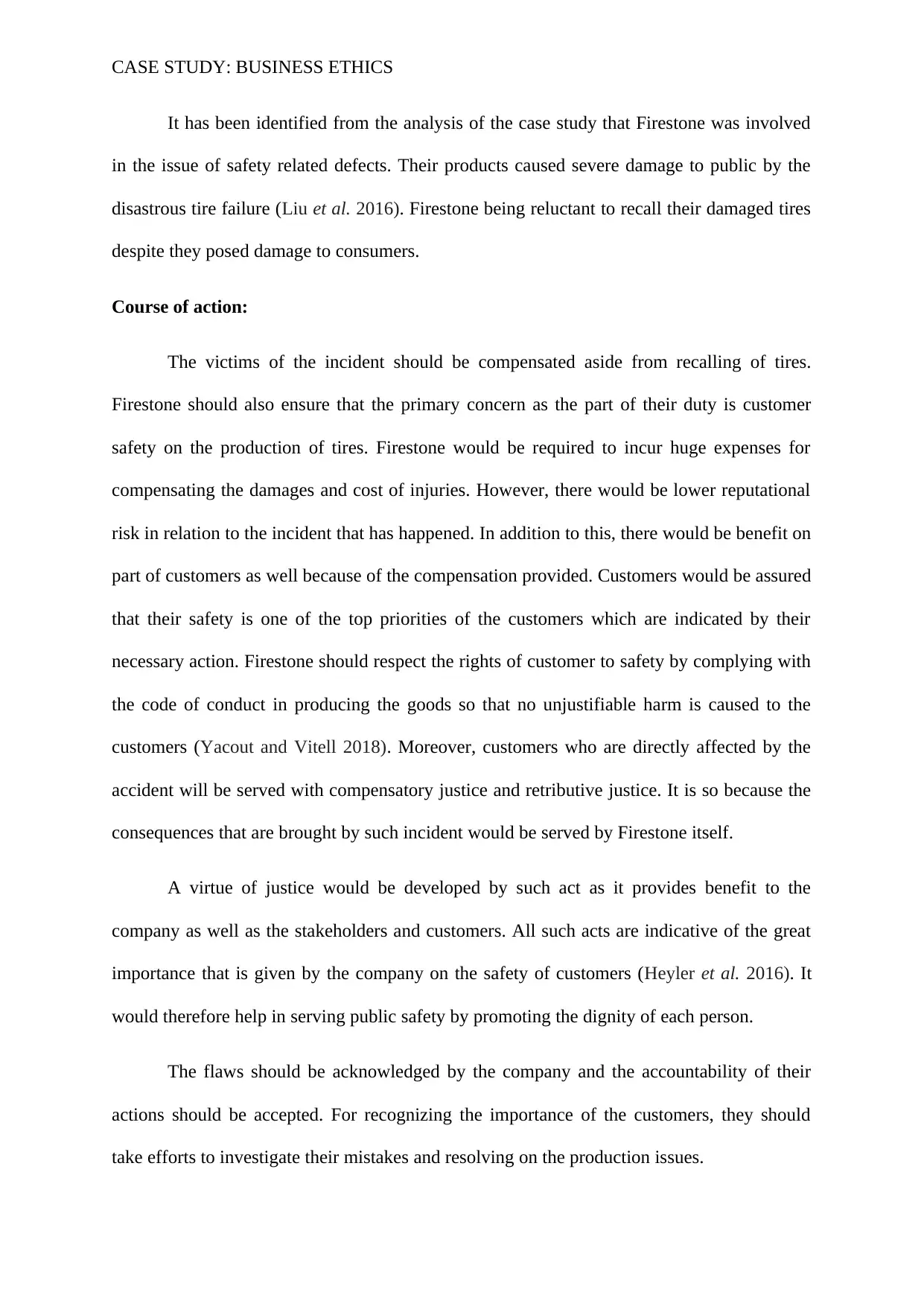
CASE STUDY: BUSINESS ETHICS
It has been identified from the analysis of the case study that Firestone was involved
in the issue of safety related defects. Their products caused severe damage to public by the
disastrous tire failure (Liu et al. 2016). Firestone being reluctant to recall their damaged tires
despite they posed damage to consumers.
Course of action:
The victims of the incident should be compensated aside from recalling of tires.
Firestone should also ensure that the primary concern as the part of their duty is customer
safety on the production of tires. Firestone would be required to incur huge expenses for
compensating the damages and cost of injuries. However, there would be lower reputational
risk in relation to the incident that has happened. In addition to this, there would be benefit on
part of customers as well because of the compensation provided. Customers would be assured
that their safety is one of the top priorities of the customers which are indicated by their
necessary action. Firestone should respect the rights of customer to safety by complying with
the code of conduct in producing the goods so that no unjustifiable harm is caused to the
customers (Yacout and Vitell 2018). Moreover, customers who are directly affected by the
accident will be served with compensatory justice and retributive justice. It is so because the
consequences that are brought by such incident would be served by Firestone itself.
A virtue of justice would be developed by such act as it provides benefit to the
company as well as the stakeholders and customers. All such acts are indicative of the great
importance that is given by the company on the safety of customers (Heyler et al. 2016). It
would therefore help in serving public safety by promoting the dignity of each person.
The flaws should be acknowledged by the company and the accountability of their
actions should be accepted. For recognizing the importance of the customers, they should
take efforts to investigate their mistakes and resolving on the production issues.
It has been identified from the analysis of the case study that Firestone was involved
in the issue of safety related defects. Their products caused severe damage to public by the
disastrous tire failure (Liu et al. 2016). Firestone being reluctant to recall their damaged tires
despite they posed damage to consumers.
Course of action:
The victims of the incident should be compensated aside from recalling of tires.
Firestone should also ensure that the primary concern as the part of their duty is customer
safety on the production of tires. Firestone would be required to incur huge expenses for
compensating the damages and cost of injuries. However, there would be lower reputational
risk in relation to the incident that has happened. In addition to this, there would be benefit on
part of customers as well because of the compensation provided. Customers would be assured
that their safety is one of the top priorities of the customers which are indicated by their
necessary action. Firestone should respect the rights of customer to safety by complying with
the code of conduct in producing the goods so that no unjustifiable harm is caused to the
customers (Yacout and Vitell 2018). Moreover, customers who are directly affected by the
accident will be served with compensatory justice and retributive justice. It is so because the
consequences that are brought by such incident would be served by Firestone itself.
A virtue of justice would be developed by such act as it provides benefit to the
company as well as the stakeholders and customers. All such acts are indicative of the great
importance that is given by the company on the safety of customers (Heyler et al. 2016). It
would therefore help in serving public safety by promoting the dignity of each person.
The flaws should be acknowledged by the company and the accountability of their
actions should be accepted. For recognizing the importance of the customers, they should
take efforts to investigate their mistakes and resolving on the production issues.
Paraphrase This Document
Need a fresh take? Get an instant paraphrase of this document with our AI Paraphraser
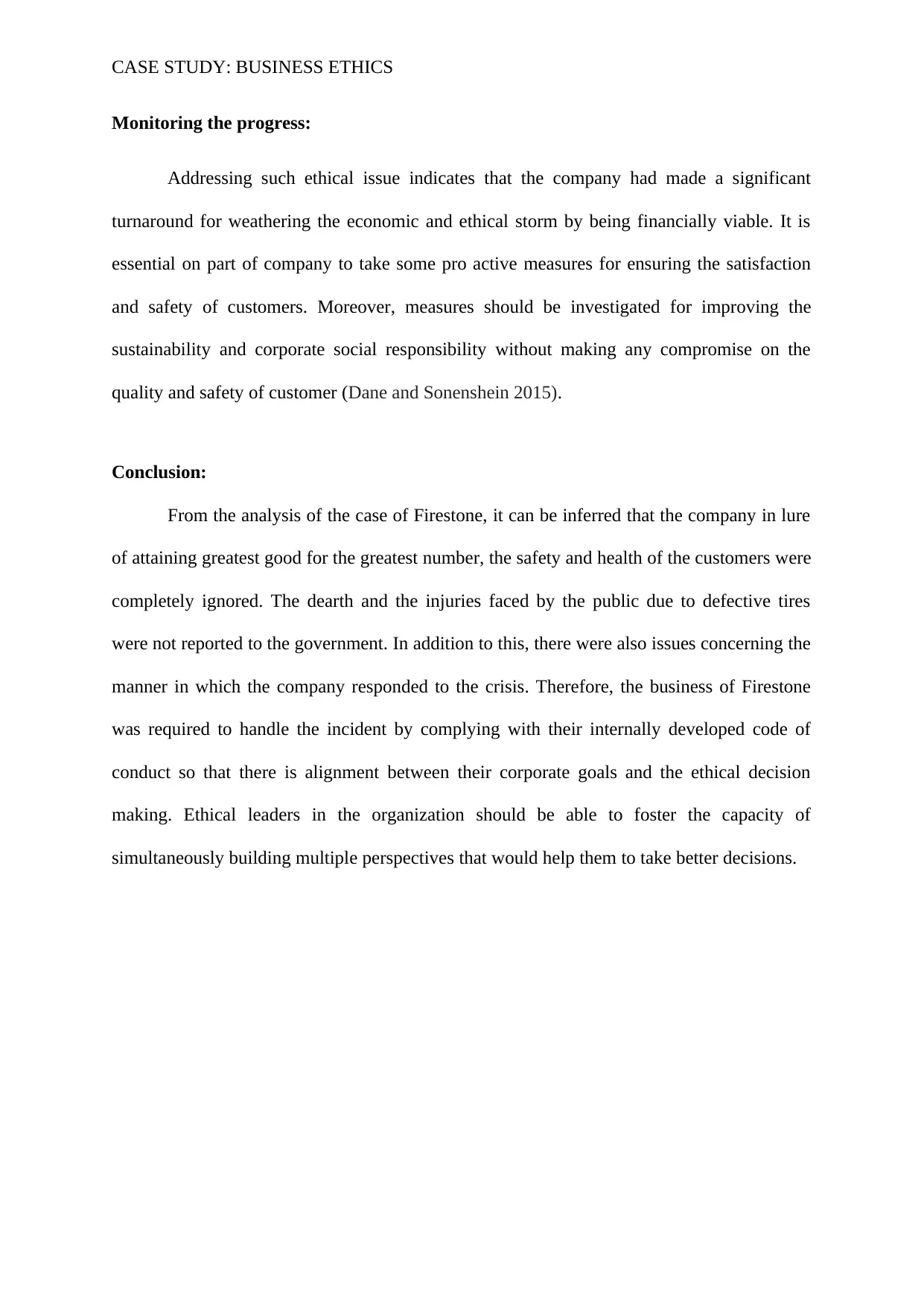
CASE STUDY: BUSINESS ETHICS
Monitoring the progress:
Addressing such ethical issue indicates that the company had made a significant
turnaround for weathering the economic and ethical storm by being financially viable. It is
essential on part of company to take some pro active measures for ensuring the satisfaction
and safety of customers. Moreover, measures should be investigated for improving the
sustainability and corporate social responsibility without making any compromise on the
quality and safety of customer (Dane and Sonenshein 2015).
Conclusion:
From the analysis of the case of Firestone, it can be inferred that the company in lure
of attaining greatest good for the greatest number, the safety and health of the customers were
completely ignored. The dearth and the injuries faced by the public due to defective tires
were not reported to the government. In addition to this, there were also issues concerning the
manner in which the company responded to the crisis. Therefore, the business of Firestone
was required to handle the incident by complying with their internally developed code of
conduct so that there is alignment between their corporate goals and the ethical decision
making. Ethical leaders in the organization should be able to foster the capacity of
simultaneously building multiple perspectives that would help them to take better decisions.
Monitoring the progress:
Addressing such ethical issue indicates that the company had made a significant
turnaround for weathering the economic and ethical storm by being financially viable. It is
essential on part of company to take some pro active measures for ensuring the satisfaction
and safety of customers. Moreover, measures should be investigated for improving the
sustainability and corporate social responsibility without making any compromise on the
quality and safety of customer (Dane and Sonenshein 2015).
Conclusion:
From the analysis of the case of Firestone, it can be inferred that the company in lure
of attaining greatest good for the greatest number, the safety and health of the customers were
completely ignored. The dearth and the injuries faced by the public due to defective tires
were not reported to the government. In addition to this, there were also issues concerning the
manner in which the company responded to the crisis. Therefore, the business of Firestone
was required to handle the incident by complying with their internally developed code of
conduct so that there is alignment between their corporate goals and the ethical decision
making. Ethical leaders in the organization should be able to foster the capacity of
simultaneously building multiple perspectives that would help them to take better decisions.

CASE STUDY: BUSINESS ETHICS
References list:
Chen, Y.S., Dooley, K. and Rungtusanatham, M.J., 2016. Using text analysis and process
modeling to examine buyer-supplier relationship dissolution: The Ford-Firestone
breakup. Journal of Purchasing and Supply Management, 22(4), pp.325-337.
Dane, E. and Sonenshein, S., 2015. On the role of experience in ethical decision making at
work: An ethical expertise perspective. Organizational Psychology Review, 5(1), pp.74-96.
Davidson, D.V., Forsythe, L.M. and Knowles, B.E., 2015. Business law: Principles and cases
in the legal environment. Wolters Kluwer Law & Business.
Eisenbeiss, S.A., Van Knippenberg, D. and Fahrbach, C.M., 2015. Doing well by doing
good? Analyzing the relationship between CEO ethical leadership and firm
performance. Journal of Business Ethics, 128(3), pp.635-651.
Erickson, S.L., Stone, M., Hanson, T.A., Tolifson, A., Ngongoni, N. and Kalthoff, J., 2017.
SHAREHOLDER VALUE AND CRISIS COMMUNICATION PATTERNS: AN
ANANLYSIS OF THE FORD AND FIRESTONE TIRE RECALL. Academy of Strategic
Management Journal, 16(1), pp.32-53.
Heyler, S.G., Armenakis, A.A., Walker, A.G. and Collier, D.Y., 2016. A qualitative study
investigating the ethical decision making process: A proposed model. The Leadership
Quarterly, 27(5), pp.788-801.
Kaul, A. and Desai, A., 2017. Building Reputational Bridges Over Crises Situations. In The
English Paradigm in India (pp. 265-284). Palgrave Macmillan, Singapore.
Liu, S.M., Liao, J.Q. and Wei, H., 2015. Authentic leadership and whistleblowing: Mediating
roles of psychological safety and personal identification. Journal of Business Ethics, 131(1),
pp.107-119.
References list:
Chen, Y.S., Dooley, K. and Rungtusanatham, M.J., 2016. Using text analysis and process
modeling to examine buyer-supplier relationship dissolution: The Ford-Firestone
breakup. Journal of Purchasing and Supply Management, 22(4), pp.325-337.
Dane, E. and Sonenshein, S., 2015. On the role of experience in ethical decision making at
work: An ethical expertise perspective. Organizational Psychology Review, 5(1), pp.74-96.
Davidson, D.V., Forsythe, L.M. and Knowles, B.E., 2015. Business law: Principles and cases
in the legal environment. Wolters Kluwer Law & Business.
Eisenbeiss, S.A., Van Knippenberg, D. and Fahrbach, C.M., 2015. Doing well by doing
good? Analyzing the relationship between CEO ethical leadership and firm
performance. Journal of Business Ethics, 128(3), pp.635-651.
Erickson, S.L., Stone, M., Hanson, T.A., Tolifson, A., Ngongoni, N. and Kalthoff, J., 2017.
SHAREHOLDER VALUE AND CRISIS COMMUNICATION PATTERNS: AN
ANANLYSIS OF THE FORD AND FIRESTONE TIRE RECALL. Academy of Strategic
Management Journal, 16(1), pp.32-53.
Heyler, S.G., Armenakis, A.A., Walker, A.G. and Collier, D.Y., 2016. A qualitative study
investigating the ethical decision making process: A proposed model. The Leadership
Quarterly, 27(5), pp.788-801.
Kaul, A. and Desai, A., 2017. Building Reputational Bridges Over Crises Situations. In The
English Paradigm in India (pp. 265-284). Palgrave Macmillan, Singapore.
Liu, S.M., Liao, J.Q. and Wei, H., 2015. Authentic leadership and whistleblowing: Mediating
roles of psychological safety and personal identification. Journal of Business Ethics, 131(1),
pp.107-119.
⊘ This is a preview!⊘
Do you want full access?
Subscribe today to unlock all pages.

Trusted by 1+ million students worldwide

CASE STUDY: BUSINESS ETHICS
Murphy, P.E. and Laczniak, G.R., 2016. Ethical Leadership for Improved Corporate
Governance and Better Business Education. In Business Ethics: New Challenges for Business
Schools and Corporate Leaders (pp. 187-207). Routledge.
Schwartz, M.S., 2016. Ethical decision-making theory: An integrated approach. Journal of
Business Ethics, 139(4), pp.755-776.
Schwartz, M.S., 2017. Business Ethics: An Ethical Decision-making Approach (Vol. 10).
John Wiley & Sons.
Shapiro, J.P. and Stefkovich, J.A., 2016. Ethical leadership and decision making in
education: Applying theoretical perspectives to complex dilemmas. Routledge.
Valentine, S., Hollingworth, D. and Schultz, P., 2016. Data-Based Ethical Decision Making,
Lateral Relations, and Organizational Commitment. In Academy of Management
Proceedings (Vol. 2016, No. 1, p. 11029). Briarcliff Manor, NY 10510: Academy of
Management.
Wittmer, D.P., 2016. Developing a behavioral model for ethical decision making in
organizations: Conceptual and empirical research. In Ethics in public management (pp. 57-
77). Routledge.
Yacout, O.M. and Vitell, S., 2018. Ethical consumer decision‐making: The role of need for
cognition and affective responses. Business Ethics: A European Review, 27(2), pp.178-194.
Murphy, P.E. and Laczniak, G.R., 2016. Ethical Leadership for Improved Corporate
Governance and Better Business Education. In Business Ethics: New Challenges for Business
Schools and Corporate Leaders (pp. 187-207). Routledge.
Schwartz, M.S., 2016. Ethical decision-making theory: An integrated approach. Journal of
Business Ethics, 139(4), pp.755-776.
Schwartz, M.S., 2017. Business Ethics: An Ethical Decision-making Approach (Vol. 10).
John Wiley & Sons.
Shapiro, J.P. and Stefkovich, J.A., 2016. Ethical leadership and decision making in
education: Applying theoretical perspectives to complex dilemmas. Routledge.
Valentine, S., Hollingworth, D. and Schultz, P., 2016. Data-Based Ethical Decision Making,
Lateral Relations, and Organizational Commitment. In Academy of Management
Proceedings (Vol. 2016, No. 1, p. 11029). Briarcliff Manor, NY 10510: Academy of
Management.
Wittmer, D.P., 2016. Developing a behavioral model for ethical decision making in
organizations: Conceptual and empirical research. In Ethics in public management (pp. 57-
77). Routledge.
Yacout, O.M. and Vitell, S., 2018. Ethical consumer decision‐making: The role of need for
cognition and affective responses. Business Ethics: A European Review, 27(2), pp.178-194.
1 out of 10
Related Documents
Your All-in-One AI-Powered Toolkit for Academic Success.
+13062052269
info@desklib.com
Available 24*7 on WhatsApp / Email
![[object Object]](/_next/static/media/star-bottom.7253800d.svg)
Unlock your academic potential
Copyright © 2020–2025 A2Z Services. All Rights Reserved. Developed and managed by ZUCOL.





